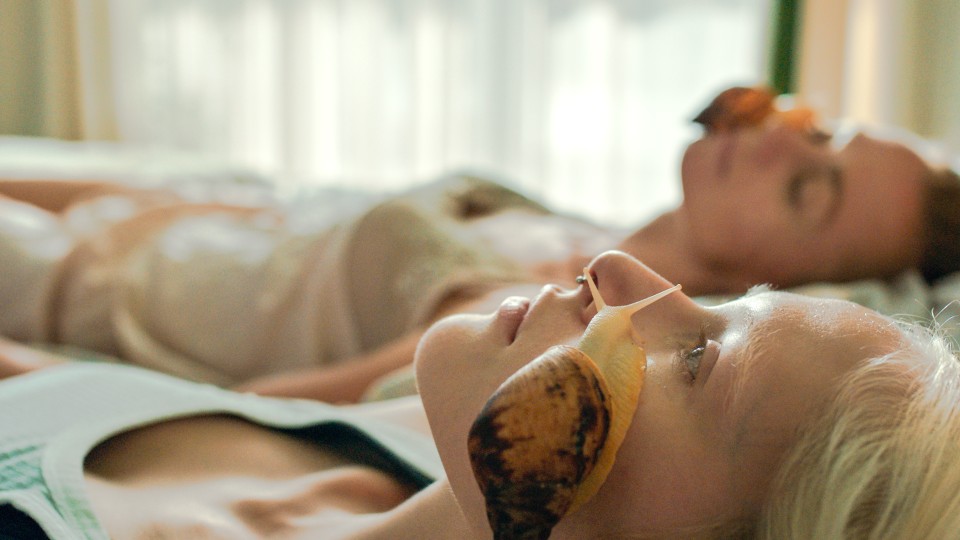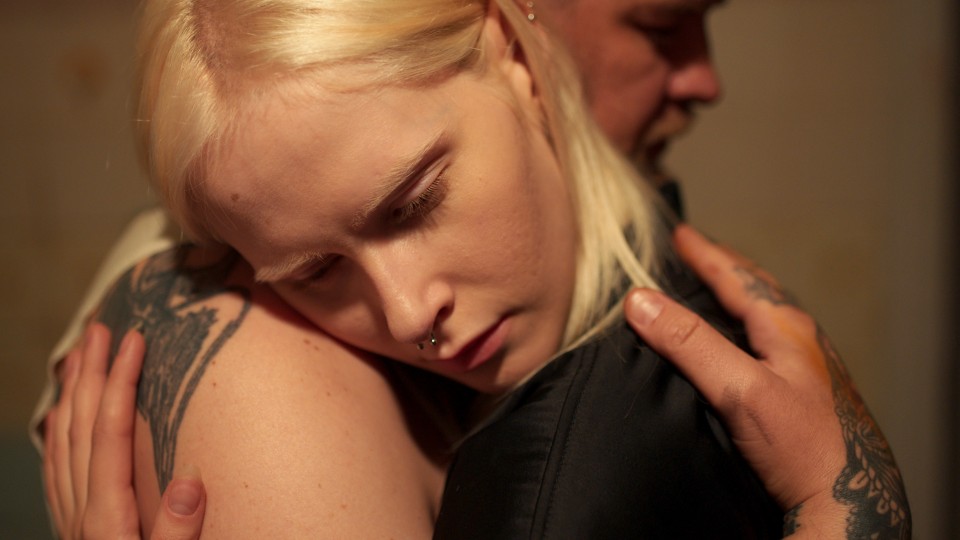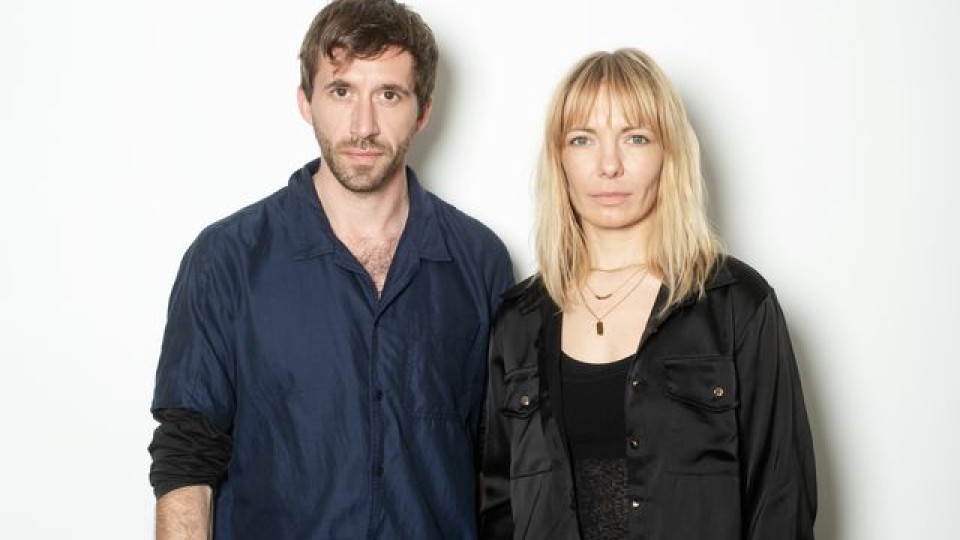Misha's skin is covered with tattoos, while Masha's is light, fragile, almost translucent. In his work, he encounters death
every day: the human body at the end of its existence. She corresponds to a current concept of ideal beauty and is in considerable
demand as a model. Over a long process, Elsa Kremser and Levin Peter have engaged with the seemingly irreconcilable realities
of their protagonists' lives. In WHITE SNAIL, they have created a contrast of almost haptic proportions between perfection and decay, and thus – in association with the
most varied locations – preparing the ground for tentative steps towards rapprochement.
The first singular aspect of this film is that it was shot for the most part in Belarus. What circumstances led to you filming
in this country?
ELSA KREMSER: The genesis of WHITE SNAIL extended over a long period. Ten years ago, I was at a festival in Minsk with my diploma film
when I was introduced to the painter Mikhail Senkov, our leading actor. I met him in a morgue, where I saw the first corpse
I’d ever encountered: a suicide victim. Immediately afterwards we went to his apartment, which was packed with oil paintings.
In one painting, a young woman was depicted as a corpse but with very alert eyes. He explained to me that this woman had survived
a suicide attempt, and that he was in contact with her. That was the starting point, and from then on, we were hooked.
How would you describe these paintings?
ELSA KREMSER: Misha worked as an autopsy assistant in a morgue for twenty years and also studied painting. His oil paintings are a surreal
blend of impressions from his workplace and the awake faces of the dead, creating an ecstatic connection.
LEVIN PETER: I’d never encountered a person who is so introverted. Then you walk through his apartment, and everything he has inside himself
is depicted. Things you don't even dare to think. His pictures are a challenge: "Look how much suffering I’ve seen." He is
very productive and constantly sent us new photos of his work. Actually, we first got to know Belarus through his paintings.
In WHITE SNAIL, you are once again active at the interface between fiction and documentary. Did you have to search for a long
time to find the second character after your chance encounter with the first?
LEVIN PETER: Our films always transcend the boundaries between forms. We also considered using documentary forms here. But we felt strongly
that Misha is so withdrawn, we wanted to prompt some radical movement in his life, so something would burst out. A documentary
portrait would have been an inventory. We needed a character who would make him open up to another person for the first time.
We wanted a woman who had never been in front of the camera before. And then it all happened fast.
ELSA KREMSER: We knew instinctively, immediately, that Masha was the right person. We weren’t trying to cast a model; she approached us
because of her thoughts about her body and her problems with depression, which she was open about. The two of them didn't
fit together at all, but we had a good gut feeling.
What prompted you to draw inspiration from fairy tale motifs, incorporating spiritual and intuitive elements?
ELSA KREMSER: Shamanism and superstition are powerful, deep-rooted elements for the people of Belarus. Constraints and the yearning to
break free of them feature strongly in this thematic complex. That's why we used a symbolism that is inherent in the country.
The two main characters embody a very striking polarity, among other things in terms of skin: Masha's is very light and fragile,
while Misha is tattooed all over. How did skin become a fundamental component of the narrative?
ELSA KREMSER: We were originally focused on forms of representation. As well as their skin, mobile phone screens were very important to
us; they function as a kind of mirror. For Masha, the main point was the image of herself on display, while Misha concentrated
on the canvas. All surfaces where you present yourself in some form, whether using your own skin with tattoos or creating
an image of a feeling in a selfie. This was a very important motif, especially in the counter-world of Masha's model school,
where it’s all about looking at skin and people, which contrasts with the examination of a body in a morgue.
What makes Masha the ideal figure in this model school as she is singled out by the teacher?
LEVIN PETER: I think it's the aloofness that makes her special. When you’re standing in front of her, you get the feeling she’s translucent
and shouldn't even be touched. She embodies something pure which needs to be protected, as if she should be placed in a bell
jar and just looked at. It makes life hard for her that there’s a lack of touch, of warmth: that she’s completely at the mercy
of herself.
How did the process of Masha and Misha getting to know each other work?
LEVIN PETER: The most important thing for all of us was that they should only meet on the first day of shooting. We had sleepless nights
about that, because we’d based everything on the premise that it had to work out. It was part of the experiment, with us accompanying
two people while they won each other over and opened up. We actually built up suspense over several years, a bit like a dating
agency. The two of them became curious about each other somehow, even though they were increasingly dubious, the closer we
got to filming. The camera, a film crew, and then this stranger; that was unimaginable for them. At the beginning it was really
difficult.
ELSA KREMSER: We only told them their part of the script beforehand, not the other person’s world.
LEVIN PETER: There was no preparation in the classic feature film sense. No learning lines, no rehearsals. We just talked to them and explained
at length, and independently of each other, what we wanted. They only came together for the first time the moment the camera
was running.
How did you deal with the risk that this approach entailed?
ELSA KREMSER: Yes, it really was a risk. We prepared a lot of narrative options as a back-up, in case something didn't work out. We were
aware that the film is an experiment in many ways. Despite the different locations, we tried to shoot as chronologically as
possible, so the two of them could really experience and live through the process. It was similar to a documentary, in that
we were sort of gathering together various elements, but since it was in the realm of fiction, that created special situations
for the departments involved.
The film focuses on the very different presence of the two bodies, but they’re both also connected with the subject of depression.
Did you feel it was important to include the element of mental wellbeing?
ELSA KREMSER: Misha virtually celebrates flaws in his paintings. The modeling world opposes them to the extreme. In principle, the point
is to confront the self-doubts you’re familiar with in your own life, in the context of finality. Why are we so preoccupied
solely with perfection, making such huge efforts to distance ourselves from death, from the abyss, from horror, even though
we’re so close to it? Before the shoot, we did an internship in a morgue for a week, together with our cameraman. If, like
Misha, you get close to death when the person isn’t a close relative, so the physical aspect of death is in the foreground,
it makes you think about self-doubt, self-image and depression in a completely different way.
LEVIN PETER: We accompanied a corpse during the entire process it goes through there, which ends – absurdly enough – with this dead person
being made up. The lifeless bodies there actually radiate a lot of truthfulness, which can also take away the fear of illness
and death. In the end, the body emerges from this building and is repackaged and made up, so the relatives don’t find it repulsive
to look at. How absurd. It's similar with the model school. That's why we juxtaposed these two places. Models have to sign
contracts committing themselves not to gain weight, change their hair color, let their hair fall out or get a suntan. There
isn’t the slightest room for exceptions. That’s why we wanted our work to present a counter-world to a person like Masha,
who is subjected to constraints like that.
How did Belarus turn out, as a filming location?
ELSA KREMSER: The original idea for the project goes back almost ten years. A lot has changed in Belarus during that time. That put our
project in jeopardy repeatedly and also changed the film, in a way. We stuck to our idea, because hardly any stories from
this region come to us anymore. We shot most of the film in Belarus, with some locations in Latvia.
LEVIN PETER: We had an incredibly open, motivated crew on site. People who love cinema and were prepared to work in a completely different
way. It was certainly challenging to shoot so much on location. We wanted to film a lot in the street, and we always felt
that including extras should mean showing something about a country which we see so little of in pictures. It was important
for us to show as much as possible about real life there.
Was WHITE SNAIL initially an urban narrative, with nature only taking a role later?
ELSA KREMSER: The natural world was part of the narrative from a very early stage, because it’s very important in Belarus. Much of the
film is based on the life stories of Masha and Misha, the rest on our personal experiences during our voyage of discovery
over these ten years. In the countryside you can find old villages where there are seers, where shamanic rituals take place
– some of which we also tested on our own bodies. That's how we came to these places and stories. A lot of it is a retelling
of our own journeys.
In the interplay between city and countryside, the use of light is also very interesting. What role does artificial, colored
light – whether from mobile phones or city lights – play as an essential aesthetic moment?
LEVIN PETER: It was clear to us that we had to combat clichés, because we ourselves were surprised when we realized what preconceptions
we had about Minsk before we went there. We had imagined dreary prefabricated buildings. We were amazed at the wild colors
that dominated the nights there, and the architecture is also very adventurous because everything is juxtaposed. There are
satellite towns built according to the Chinese model, which look very futuristic, malls with extremely colorful decor.
ELSA KREMSER: We were impressed by the modernity of the city; Minsk is clinically clean with modern planning. That influenced our use of
light, as well as the fact that light penetrates into every corner, so there’s no unlit space.
What form did editing take, in the long story of the film’s creation?
ELSA KREMSER: We shot over almost 50 days in 2023, which was necessary but not so easy to put into practice, because we this time we weren’t
a small documentary team. Filming for so many days gave us the chance to try lots of things, to let Masha and Misha "run with
it". We’d often have takes that were 30 to 45 minutes long. That could represent a huge challenge for the crew, if the location
was a park with the two of them walking along, without the location or the end of the scene being defined. And that in turn
meant that editing the material was a special process. Even though there are many documentary elements, WHITE SNAIL has an
unalterable basic story, and that was hugely different to the situation with previous films, where we had to form something
entirely from the available material.
Interview: Karin Schiefer | AUSTRIAN FILMS
June 2025
Translation: Charles Osborne






